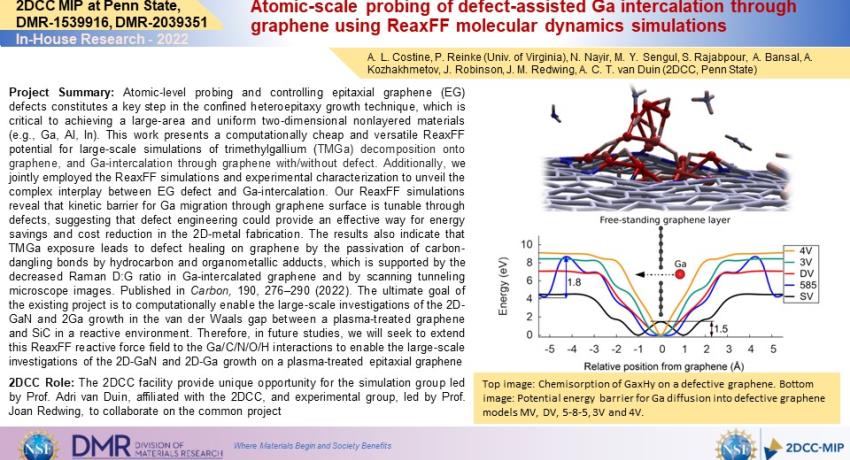Project Summary: Atomic-level probing and controlling epitaxial graphene (EG) defects constitutes a key step in the confined heteroepitaxy growth technique, which is critical to achieving a large-area and uniform two-dimensional nonlayered materials (e.g., Ga, Al, In). This work presents a computationally cheap and versatile ReaxFF potential for large-scale simulations of trimethylgallium (TMGa) decomposition onto graphene, and Ga-intercalation through graphene with/without defect. Additionally, we jointly employed the ReaxFF simulations and experimental characterization to unveil the complex interplay between EG defect and Ga-intercalation. Our ReaxFF simulations reveal that kinetic barrier for Ga migration through graphene surface is tunable through defects, suggesting that defect engineering could provide an effective way for energy savings and cost reduction in the 2D-metal fabrication. The results also indicate that TMGa exposure leads to defect healing on graphene by the passivation of carbon-dangling bonds by hydrocarbon and organometallic adducts, which is supported by the decreased Raman D:G ratio in Ga-intercalated graphene and by scanning tunneling microscope images. Published in Carbon, 190, 276–290 (2022). The ultimate goal of the existing project is to computationally enable the large-scale investigations of the 2D-GaN and 2Ga growth in the van der Waals gap between a plasma-treated graphene and SiC in a reactive environment. Therefore, in future studies, we will seek to extend this ReaxFF reactive force field to the Ga/C/N/O/H interactions to enable the large-scale investigations of the 2D-GaN and 2D-Ga growth on a plasma-treated epitaxial graphene
2DCC Role: The 2DCC facility provide unique opportunity for the simulation group led by Prof. Adri van Duin, affiliated with the 2DCC, and experimental group, led by Prof. Joan Redwing, to collaborate on the common project
What Has Been Achieved: A new ReaxFF force field is made available to the Materials Science Community. Additionally, we demonstrated the modulation effect of defect engineering of EG on its transport properties, and thereby, its critical role on the growth of 2D Ga.
Importance of the Achievement: Defects in a graphene film significantly impact transport properties. Illuminating the complex interplay between defects and EG provide clues into the atomistic mechanism of intercalation process that will make it possible to control the growth conditions, and thus, to synthesize large area and uniform 2D-Ga.
Unique Feature(s) of the MIP that Enabled this Achievement: In-house expertise on ReaxFF simulation, and high-quality, wafer-scale 2D material synthesis
(If Applicable) Publication: N. Nayir, M. Y. Sengul, A. L. Costine, P. Reinke, S. Rajabpour, A. Bansal, A. Kozhakhmetov, J. Robinson, J. M. Redwing, A. van Duin, “Atomic-scale probing of defect-assisted Ga intercalation through graphene using ReaxFF Molecular Dynamics Simulations”, Carbon, 190, 276–290 (2022)
Acknowledgments: N.N., A.vD and J. M. R. acknowledge that this work was financially supported by the National Science Foundation (NSF) through the Pennsylvania State University 2D Crystal Consortium−Materials Innovation Platform (2DCC-MIP) under the NSF cooperative agreements DMR-1808900, DMR-1539916 and DMR-2039351. P. R and A. B. also acknowledge support from the National Science Foundation award CHE-1507986 by the Division of Chemistry (Macromolecular, Supramolecular and Nanochemistry).
